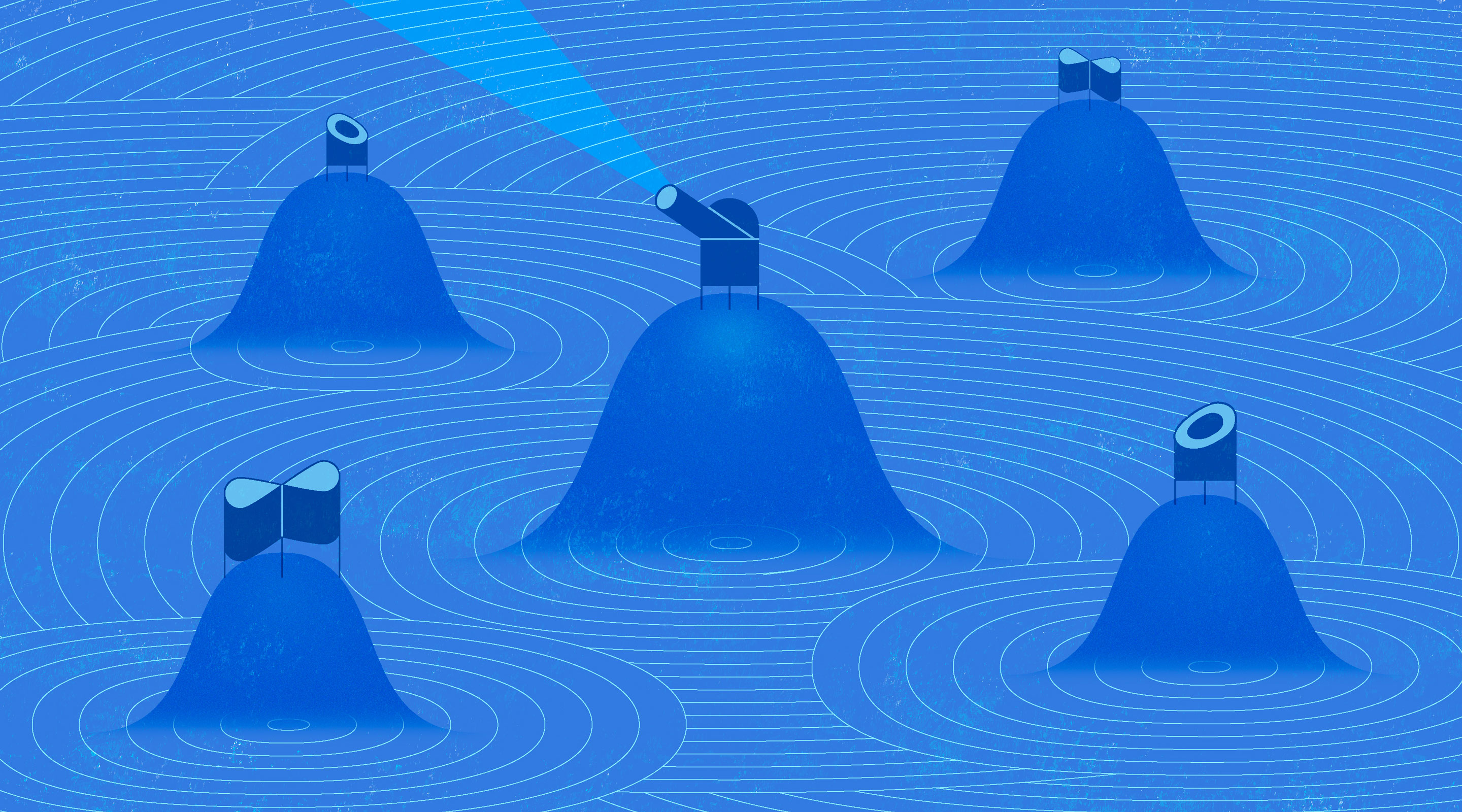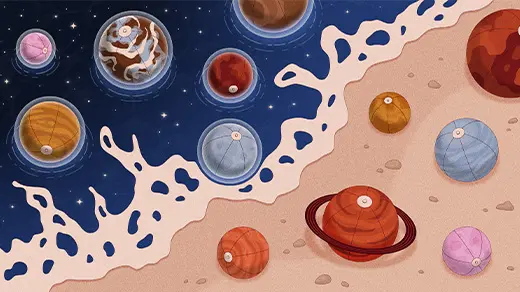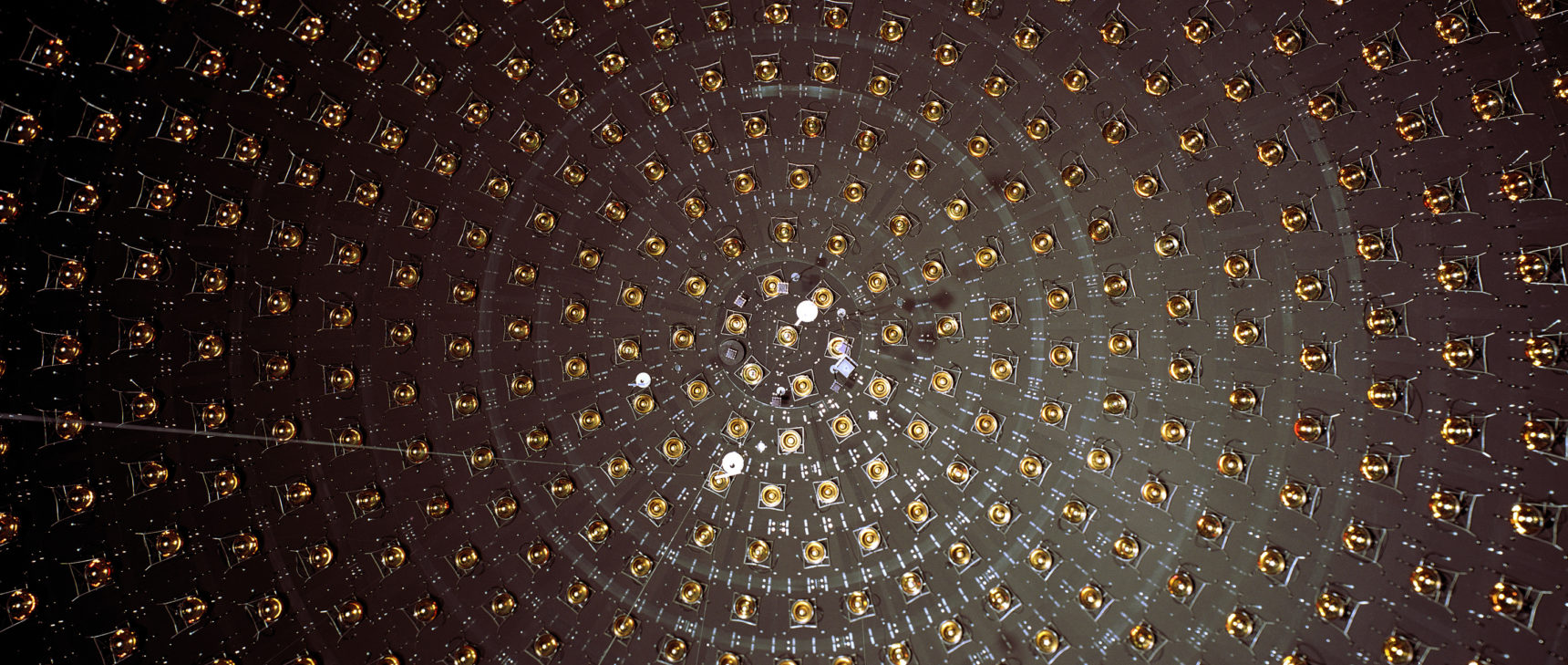There Are No Laws of Physics. There’s Only the Landscape.

James O’Brien for Quanta Magazine
Introduction
Suppose Alice and Bob are both asked to prepare a meal. Alice likes Chinese, Bob likes Italian. They each pick their favorite recipe, shop at the local specialty store, and carefully follow the instructions. But when they take their dishes out of the oven, they are in for a big surprise. The two meals turn out to be identical. We can imagine the existential questions Alice and Bob must ask themselves. How can different ingredients produce the same dish? What does it even mean to cook Chinese or Italian? And is their approach to preparing food totally flawed?
This is exactly the perplexity experienced by quantum physicists. They have found many examples of two completely different descriptions of the same physical system. In the case of physics, instead of meats and sauces, the ingredients are particles and forces; the recipes are mathematical formulas encoding the interactions; and the cooking process is the quantization procedure that turns equations into the probabilities of physical phenomena. Just like Alice and Bob, quantum physicists wonder how different recipes lead to the same outcomes.
Did nature have any choice in picking its fundamental laws? Albert Einstein famously believed that, given some general principles, there is essentially a unique way to construct a consistent, functioning universe. In Einstein’s view, if we probed the essence of physics deeply enough, there would be one and only one way in which all the components — matter, radiation, forces, space and time — would fit together to make reality work, just as the gears, springs, dials and wheels of a mechanical clock uniquely combine to keep time.
The current Standard Model of particle physics is indeed a tightly constructed mechanism with only a handful of ingredients. Yet instead of being unique, the universe seems to be one of an infinitude of possible worlds. We have no clue why this particular combination of particles and forces underlies nature’s structure. Why are there six “flavors” of quarks, three “generations” of neutrinos, and one Higgs particle? Furthermore, the Standard Model comes with 19 constants of nature — numbers like the mass and charge of the electron — that have to be measured in experiments. The values of these “free parameters” seem to be without any deeper meaning. On the one hand, particle physics is a wonder of elegance; on the other hand, it is a just-so story.
If our world is but one of many, how do we deal with the alternatives? The current point of view can be seen as the polar opposite of Einstein’s dream of a unique cosmos. Modern physicists embrace the vast space of possibilities and try to understand its overarching logic and interconnectedness. From gold diggers they have turned into geographers and geologists, mapping the landscape in detail and studying the forces that have shaped it.
The game changer that led to this switch of perspective has been string theory. At this moment it is the only viable candidate for a theory of nature able to describe all particles and forces, including gravity, while obeying the strict logical rules of quantum mechanics and relativity. The good news is that string theory has no free parameters. It has no dials that can be turned. It doesn’t make sense to ask which string theory describes our universe, because there is only one. The absence of any additional features leads to a radical consequence. All numbers in nature should be determined by physics itself. They are no “constants of nature,” only variables that are fixed by equations (perhaps intractably complicated ones).
Which brings us to the bad news. String theory’s space of solutions is vast and complex. This is not unusual in physics. We traditionally distinguish between fundamental laws given by mathematical equations, and the solutions of these equations. Typically, there are only a few laws, but an infinite number of solutions. Take Newton’s laws. They are crisp and elegant but describe an incredibly wide range of phenomena, from a falling apple to the orbit of the moon. If you know the initial conditions of a specific system, the power of these laws allows you to solve the equations and predict what is going to happen next. We do not expect, nor demand, an a priori unique solution that describes everything.
In string theory, certain features of physics that we usually would consider laws of nature — such as specific particles and forces — are in fact solutions. They are determined by the shape and size of hidden extra dimensions. The space of all of these solutions is often referred to as “the landscape,” but that is a wild understatement. Even the most awe-inspiring mountain vistas pale in comparison with the immensity of this space. Although its geography is only marginally understood, we know it has continents of huge dimensions. One of the most tantalizing features is that possibly everything is connected — that is, every two models are connected by an unbroken path. By shaking the universe hard enough, we would be able to move from one possible world to another, changing what we consider the immutable laws of nature and the special combination of elementary particles that make up reality.
But how do we explore the vast landscape of physical models of the universe that might easily have hundreds of dimensions? It’s helpful to visualize the landscape as a largely undeveloped wilderness, most of it hidden under thick layers of intractable complexity. Only at the very edges do we find habitable places. In these outposts, life is simple and good. Here we find the basic models that we fully understand. They are of little value in describing the real world, but serve as convenient starting points to explore the local neighborhood.
A good example is QED, the theory of quantum electrodynamics that describes the interactions between matter and light. This model has a single parameter, called the fine-structure constant α, which measures the strength of the force between two electrons. Numerically, it is close to $latex ^1/_{137}$. In QED, all processes can be seen as arising out of elementary interactions. For example, the repulsive force between two electrons can be visualized as an exchange of photons. QED asks us to consider all possible ways that two electrons might exchange a photon, which in practice would mean that physicists have to solve an infinite sum of great complexity. But the theory also offers a way out: Each additional photon exchange adds a term that includes α raised to an additional power. Since this is a relatively small number, the terms with many exchanges make only a small contribution. They can be neglected in an approximation to the “real” value.
We find these weakly coupled theories at the outposts of the landscape. Here the strength of the forces is small and it makes sense to talk about the shopping list of elementary particles and the recipe that computes their interactions. But if we leave the immediate environment and travel more deeply into the wilderness, the couplings become large and each additional term in the expansion grows more important. Now we can no longer distinguish the individual particles. Instead they dissolve into an entangled mesh of energy like the ingredients of a cake in a hot oven.
However, not everything is lost. Sometimes the path through the dark wilderness ends at another outpost. That is, at a different well-controlled model, this time made out of a completely different set of particles and forces. In such cases, there are two alternative recipes for the same underlying physics, just as with Alice and Bob’s dishes. These complementary descriptions are called dual models, and the relation between them a duality. We can consider these dualities as a grand generalization of the famous particle-wave duality discovered by Heisenberg. For Alice and Bob, it takes the form of a translation between Chinese and Italian recipes.
Why is this all so exciting for physics? First of all, the conclusion that many, if not all, models are part of one huge interconnected space is among the most astonishing results of modern quantum physics. It is a change of perspective worthy of the term “paradigm shift.” It tells us that instead of exploring an archipelago of individual islands, we have discovered one massive continent. In some sense, by studying one model deeply enough, we can study them all. We can explore how these models are related, illuminating their common structures. It is important to stress that this phenomenon is largely independent of the question of whether string theory describes the real world or not. It is an intrinsic property of quantum physics that is here to stay, whatever the future “theory of everything” will turn out to be.
A more dramatic conclusion is that all traditional descriptions of fundamental physics have to be thrown out. Particles, fields, forces, symmetries — they are all just artifacts of a simple existence at the outposts in this vast landscape of impenetrable complexity. Thinking of physics in terms of elementary building blocks appears to be wrong, or at least of limited reach. Perhaps there is a radical new framework uniting the fundamental laws of nature that disregards all the familiar concepts. The mathematical intricacies and consistencies of string theory are a strong motivation for this dramatic point of view. But we have to be honest. Very few current ideas about what replaces particles and fields are “crazy enough to be true,” to quote Niels Bohr. Like Alice and Bob, physics is ready to throw out the old recipes and embrace a modern fusion cuisine.



